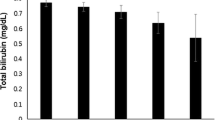Abstract
Aims
Although a relationship between serum bilirubin concentration and diabetic microangiopathy in patients with type 2 diabetes has been reported, whether such a relationship exists in patients with type 1 diabetes is unknown. This study assessed the relationships between serum total bilirubin concentration and retinopathy/nephropathy in patients with type 1 diabetes.
Methods
A total of 126 patients with type 1 diabetes were investigated in this cross-sectional study. Serum total bilirubin concentration was compared between patients with and without diabetic retinopathy/nephropathy, and among the categories stratified according to the severity of retinopathy/nephropathy. A logistic regression model was used to assess the association of retinopathy/nephropathy with total bilirubin. Finally, total bilirubin concentration was compared among patients with none, either, or both diabetic retinopathy and nephropathy.
Results
Serum total bilirubin concentration was significantly lower in patients with retinopathy/nephropathy than in those without complications. Receiver operating characteristic analysis indicated that a bilirubin concentration of 0.55 mg/dl might be the appropriate threshold for the detection of retinopathy/nephropathy. Total bilirubin concentration differed significantly according to the severity of microangiopathy. In logistic regression analyses, total bilirubin level was significantly inversely associated with retinopathy/nephropathy. Moreover, bilirubin level in patients with either retinopathy or nephropathy was significantly higher than that in patients with both of them, and significantly lower than that in patients with neither of them.
Conclusions
Total bilirubin concentration was shown to be lower in patients with type 1 diabetes complicated by retinopathy/nephropathy. Bilirubin might function protectively against microangiopathy in patients with type 1 diabetes.
Similar content being viewed by others
References
Stocker R, Yamamoto Y, McDonagh AF, et al. Bilirubin is an antioxidant of possible physiological importance. Science. 1987;235:1043–6.
Stocker R, Glazer A, Ames B. Antioxidant activity of albumin-bound bilirubin. Proc Natl Acad Sci USA. 1987;84:5918–22.
Baranano DE, Rao M, Ferris CD, Snyder SH. Biliverdin reductase: a major physiological cytoprotectant. Proc Natl Acad Sci USA. 2002;99:16093–8.
Kawamura K, Ishikawa K, Wada Y, et al. Bilirubin from heme oxygenase-1 attenuates vascular endothelial activation and dysfunction. Arterioscler Thromb Vasc Biol. 2005;25:155–60.
Mazzone GL, Rigato I, Ostrow JD, et al. Bilirubin inhibits the TNF alpha-related induction of three endothelial adhesion molecules. Biochem Biophys Res Commun. 2009;386:338–44.
Basiglio CL, Arriaga SM, Pelusa F, et al. Complement activation and disease: protective effects of hyperbilirubinemia. Clin Sci (Lond). 2009;118:99–113.
Inoguchi T, Sasaki S, Kobayashi K, et al. Relationship between Gilbert syndrome and prevalence of vascular complications in patients with diabetes. J Am Med Assoc. 2007;298:1398–400.
Vitek L, Jirsa M, Brodanova M, et al. Gilbert syndrome and ischemic heart disease: a protective effect of elevated bilirubin levels. Atherosclerosis. 2002;160:449–56.
Fukui M, Tanaka M, Shiraishi E, et al. Relationship between serum bilirubin and albuminuria in patients with type 2 diabetes. Kidney Int. 2008;74:1197–201.
Mashitani T, Hayashino Y, Okamura S, et al. Correlations between serum bilirubin levels and diabetic nephropathy progression among Japanese type 2 diabetic patients: a prospective cohort study (Diabetes Distress and Care Registry at Tenri [DDCRT 5]). Diabetes Care. 2014;37:252–8.
Yasuda M, Kiyohara Y, Wang JJ, et al. High serum bilirubin levels and diabetic retinopathy: the Hisayama study. Ophthalmology. 2011;118:1423–8.
Davis MD, Kern TS, Rand LI. Diabetic retinopathy. In: Alberti KG, Zimmet P, DeFronzo RA, editors. International textbook of diabetes mellitus. 2nd ed. Chichester: Wiley; 1997. p. 1413–46.
Committee of the Japan Diabetes Society on the Diagnostic Criteria of Diabetes Mellitus, Seino Y, Nanjo K, et al. Report of the Committee on the Classification and Diagnostic Criteria of Diabetes Mellitus. J Diabetes Invest. 2010;19:212–28.
Matsuo S, Imai E, Horio M, et al. Revised equations for estimated GFR from serum creatinine in Japan. Am J Kidney Dis. 2009;53:982–92.
Horio M, Imai E, Yasuda Y, et al. Modification of the CKD epidemiology collaboration (CKD-EPI) equation for Japanese: accuracy and use for population estimates. Am J Kidney Dis. 2010;56:32–8.
Madsen-Bouterse SA, Kowluru RA. Oxidative stress and diabetic retinopathy: pathophysiological mechanisms and treatment perspectives. Rev Endocr Metab Disord. 2008;9:315–27.
Frank RN. Diabetic retinopathy. N Engl J Med. 2004;350:48–58.
Garrido AM, Griendling KK. NADPH oxidases and angiotensin II receptor signaling. Mol Cell Endocrinol. 2009;302:148–58.
Marrero MB, Fulton D, Stepp D, et al. Angiotensin II induced signaling pathways in diabetes. Curr Diabetes Rev. 2005;1:197–202.
Cachofeiro V, Goicochea M, de Vinuesa SG, et al. Oxidative stress and inflammation, a link between chronic kidney disease and cardiovascular disease. Kidney Int Suppl. 2008;111:S4–9.
Rodriguez F, Lopez B, Perez C, et al. Chronic tempol treatment attenuates the renal hemodynamic effects induced by a heme oxygenase inhibitor in streptozotocin diabetic rats. Am J Physiol Regul Integr Comp Physiol. 2011;301:R1540–8.
Karvonen M, Viik-Kajander M, Moltchanova E, et al. Incidence of childhood type 1 diabetes worldwide. Diabetes Mondiale (DiaMond) Project Group. Diabetes Care. 2000;23:1516–26.
Asao K, Sarti C, Forsen T, et al. Long-term mortality in nationwide cohorts of childhood-onset type 1 diabetes in Japan and Finland. Diabetes Care. 2003;26:2037–42.
Conflict of interest
R.S., M.T., and T.N. declare that they have no conflict of interest. H.I. has received compensation from NIPRO, lecture fees from Takeda and MSD, and scholarship grants from Sanofi-Aventis, Astellas, Takeda, MSD, and Daiichi Sankyo.
Human rights statement and informed consent
All procedures followed were in accordance with the ethical standards of the responsible committee on human experimentation (Keio University School of Medicine, an Ethical Committee) and with the Helsinki Declaration of 1964 and its subsequent revision. Informed consent was obtained from all patients to be included in the study.
Author information
Authors and Affiliations
Corresponding author
About this article
Cite this article
Sekioka, R., Tanaka, M., Nishimura, T. et al. Low serum total bilirubin concentration in patients with type 1 diabetes mellitus complicated by retinopathy and nephropathy. Diabetol Int 6, 300–305 (2015). https://doi.org/10.1007/s13340-014-0201-z
Received:
Accepted:
Published:
Issue Date:
DOI: https://doi.org/10.1007/s13340-014-0201-z




